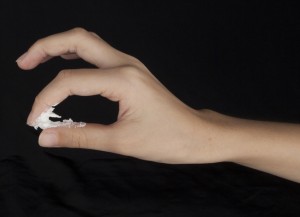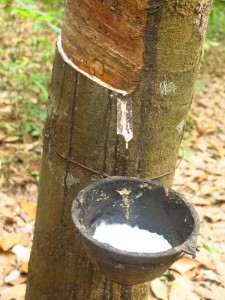
“I am rubber, you are glue. Bounce off me and stick to you.” Who hasn’t used that old schoolyard taunt at least once or twice to turn an insult back on his foe? When you’re a kid, the rhyme seems the height of sophisticated disdain. But get a few years of adulthood under your belt and you realize that rubber isn’t always bouncy. Sometimes, rubber is as sticky as glue!
Recently, we told you why rubber dry rots, and that when rubber breaks down, it’s not really rotting, it’s responding to environmental conditions like extreme temperatures and UV exposure. So what happens when rubber turns sticky? Is there any cure to correct the problem once it occurs?
Well, if you remember what we said in our earlier blog, natural rubber comes from plants and synthetic rubber is made from petroleum products. In both cases, the material that will become rubber starts out life in a sticky condition.

For example, the rubber tree emits a sticky syrup that we can refine into rubber. That’s actually latex — rubber particles in water. It’s as sticky as maple syrup because the molecules in the substance are long chains with very weak links to each other. To turn that raw material into rubber, it is put through a vulcanizing process (also known as curing or crosslinking) which involves heating the latex with sulfur (and other additives). Vulcanization causes the polymer chains of the latex to join together into a network that increases the molecular weight and causes the material to be stretchy — and no longer sticky.
Now just as the environment can cause rubber to crack, flake and decay — “dry rot” — it can also cause the rubber to revert back to its original state. We call that reversion, and it happens when the stronger polymer crosslinks get snipped and the molecules revert back into their original small chains. The rubber starts behaving more like latex, and any insults you hurl at the failing rubber product will probably stick, rather than bounce off!
Reversion isn’t always a bad thing. We can use it to recycle rubber so it can be used again or made into something new. For example, old car tires are now being used to make a wide range of products, from construction materials to mousepads!
Still, you probably don’t want reversion to happen to your rubber product the first time you’re using the rubber. Stabilizers (those additives we mentioned earlier) can help reduce the risk and extent of reversion. We can also do comparative analysis to determine if a sticky rubber was made of the right polymer but lost crosslink density, or if the gel content has declined. Physical tests can reveal if the elasticity and strength have decreased. Polymer analysis can help manufacturers understand and improve their rubber formula to ensure products made from their rubber will perform as intended for as long as possible.
